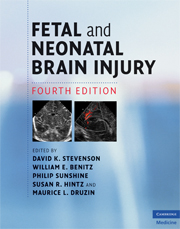Book contents
- Frontmatter
- Contents
- List of contributors
- Foreword
- Preface
- Section 1 Epidemiology, pathophysiology, and pathogenesis of fetal and neonatal brain injury
- Section 2 Pregnancy, labor, and delivery complications causing brain injury
- Section 3 Diagnosis of the infant with brain injury
- Section 4 Specific conditions associated with fetal and neonatal brain injury
- 22 Congenital malformations of the brain
- 23 Neurogenetic disorders of the brain
- 24 Hemorrhagic lesions of the central nervous system
- 25 Neonatal stroke
- 26 Hypoglycemia in the neonate
- 27 Hyperbilirubinemia and kernicterus
- 28 Polycythemia and fetal–maternal bleeding
- 29 Hydrops fetalis
- 30 Bacterial sepsis in the neonate
- 31 Neonatal bacterial meningitis
- 32 Neurological sequelae of congenital perinatal infection
- 33 Perinatal human immunodeficiency virus infection
- 34 Inborn errors of metabolism with features of hypoxic–ischemic encephalopathy
- 35 Acidosis and alkalosis
- 36 Meconium staining and the meconium aspiration syndrome
- 37 Persistent pulmonary hypertension of the newborn
- 38 Pediatric cardiac surgery: relevance to fetal and neonatal brain injury
- Section 5 Management of the depressed or neurologically dysfunctional neonate
- Section 6 Assessing outcome of the brain-injured infant
- Index
- Plate section
- References
23 - Neurogenetic disorders of the brain
from Section 4 - Specific conditions associated with fetal and neonatal brain injury
Published online by Cambridge University Press: 12 January 2010
- Frontmatter
- Contents
- List of contributors
- Foreword
- Preface
- Section 1 Epidemiology, pathophysiology, and pathogenesis of fetal and neonatal brain injury
- Section 2 Pregnancy, labor, and delivery complications causing brain injury
- Section 3 Diagnosis of the infant with brain injury
- Section 4 Specific conditions associated with fetal and neonatal brain injury
- 22 Congenital malformations of the brain
- 23 Neurogenetic disorders of the brain
- 24 Hemorrhagic lesions of the central nervous system
- 25 Neonatal stroke
- 26 Hypoglycemia in the neonate
- 27 Hyperbilirubinemia and kernicterus
- 28 Polycythemia and fetal–maternal bleeding
- 29 Hydrops fetalis
- 30 Bacterial sepsis in the neonate
- 31 Neonatal bacterial meningitis
- 32 Neurological sequelae of congenital perinatal infection
- 33 Perinatal human immunodeficiency virus infection
- 34 Inborn errors of metabolism with features of hypoxic–ischemic encephalopathy
- 35 Acidosis and alkalosis
- 36 Meconium staining and the meconium aspiration syndrome
- 37 Persistent pulmonary hypertension of the newborn
- 38 Pediatric cardiac surgery: relevance to fetal and neonatal brain injury
- Section 5 Management of the depressed or neurologically dysfunctional neonate
- Section 6 Assessing outcome of the brain-injured infant
- Index
- Plate section
- References
Summary
Introduction
A number of genetic disorders share clinical features with fetal and neonatal brain injury. Although these conditions are individually rare, collectively they should be expected encounters in the neonatal intensive care setting. This chapter aims to familiarize the reader with select inherited conditions that may clinically mimic neonatal brain injury. The majority of genetic conditions with clinical resemblance to neonatal brain injury discussed here present with hypotonia. Other syndromes can result in central nervous system hemorrhage, findings similar to congenital infection, hydrocephalus, and central hypoventilation.
Conditions included in this chapter do not ordinarily present with malformations or minor anomalies. Such conditions should be readily distinguishable from the sequelae of fetal and neonatal injury. Several inborn errors of metabolism have clinical findings similar to hypoxic–ischemic encephalopathy (HIE). These disorders are reviewed in Chapter 34.
The following discussion of inherited disorders with features similar to those of fetal and neonatal brain injury begins with an overview of the clinical genetics evaluation and its rationale. Subsequently, the chapter is organized by clinical presentation: hypotonia, apparent congenital infection, intracranial hemorrhage, hydrocephalus, and central hypoventilation. Information regarding clinical findings, diagnostic approach, and management is provided. A brief overview of management is also provided. References are included for additional reading.
- Type
- Chapter
- Information
- Fetal and Neonatal Brain Injury , pp. 277 - 284Publisher: Cambridge University PressPrint publication year: 2009



